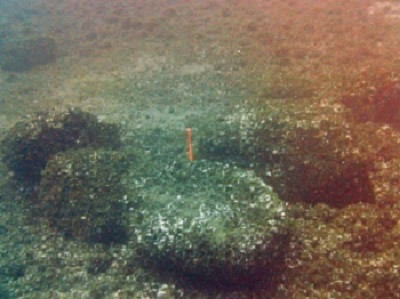9,000-Year-Old Caribou Hunting Ground Beneath Lake Huron Reveals Ancient Hunting Techniques

An ancient caribou hunting ground has been discovered submerged beneath Lake Huron, one of the five Great Lakes of North America.
The 9,000-year-old hunt area, which is constructed on limestone bedrock, was discovered by researchers from the University of Michigan's Museum of Anthropology. It consists of an elaborate array of linear stone lanes and V-shaped structures, thought to be the most complex display of hunting structures and techniques ever discovered.
John O'Shea, an anthropological archaeology professor at the University of Michigan, told the Newark Advocate: "One reason this area was so valuable is that it provided predictability for ancient hunters."
He said that hunters of the late Paleoindian-Early Archaic periods were confident the animals would have to pass through the area. "If you guessed wrong about where the animals are, you may very well be dead. There was a lot of pressure on getting it right," O'Shea added.

Described by the team as a man-made "drive lane", dubbed the Drop 45 Drive Lane, the parallel lines lead to a cul-de-sac formed by the cobble pavement. Three circular hunting "blinds" built into the lines are flanked by additional stone alignments which likely served as obstructions for corralling caribou.
"For mobile hunters, this is a really valuable time, because they share information, they trade, they have marriages, they do all these things that you only do when you get a critical mass of people together," O'Shea said in an interview with CBC News.
"This is, I think, giving us a really unique picture of what that whole annual cycle was that these hunters were following."
The area on which the structure was found, called the Alpena-Amberley Ridge, was a dry corridor linking modern northeastern Michigan and southern Ontario. Located approximately 35 miles southeast of Alpena, it is now submerged beneath 120ft of water.
Using underwater sonar equipment and a remotely operated vehicle equipped with a video camera, the team discovered the parallel lines of stones that create a 26ft-wide and 98ft-long lane that ends in a natural cul-de-sac.
Researchers also found V-shaped hunting blinds and a rectagular area which may have been used as a meat cache. The blinds are thought to have provided an area from which a hunter could hide and ambush their prey.
The team investigated the site and recovered 11 stone flakes near the lanes, which they believed may have been used to maintain stone tools and weapons.
Predicting where the caribou would have travelled during the spring and autumn migrations, they identified two main areas where the caribou would have likely converged during both seasons. One of the two points was located within the Drop 45 Drive Lane.
As reported in Live Science, O'Shea said similar structures have been found in the North American Arctic but are rarely preserved due to "disturbance by subsequent settlers for farming or road construction".
The research was published in the journal Proceedings of the National Academy of Sciences.
© Copyright IBTimes 2025. All rights reserved.






















